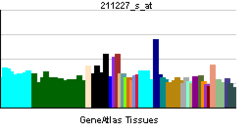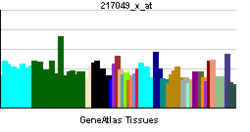PCDH11X
Protocadherin 11 X-linked, also known as PCDH11X, is a protein which in humans is encoded by the PCDH11X gene.[4][5]
Function
This gene belongs to the protocadherin gene family, a subfamily of the cadherin superfamily. The encoded protein consists of an extracellular domain containing 7 cadherin repeats, a transmembrane domain and a cytoplasmic tail that differs from those of the classical cadherins. The gene is located in a major X/Y block of homology and its Y homolog (PCDHY), despite divergence leading to coding region changes, is the most closely related cadherin family member. The protein is thought to play a fundamental role in cell-cell recognition essential for the segmental development and function of the central nervous system. Transcripts arising from alternative splicing encode isoforms with variable cytoplasmic domains.[4]
Clinical significance
In a genome-wide association study, the PCDH11X gene has been linked as a risk factor in late onset Alzheimer's disease,[6] but other studies on different populations [7][8][9][10] could not confirm the initial association. The clinical significance of this gene is unclear, and the gene might play different roles in different population specific contexts.
References
- ↑ "Diseases that are genetically associated with PCDH11X view/edit references on wikidata".
- ↑ "Human PubMed Reference:".
- ↑ "Mouse PubMed Reference:".
- 1 2 "Entrez Gene: PCDH11X protocadherin 11 X-linked".
- ↑ Yoshida K, Sugano S (December 1999). "Identification of a novel protocadherin gene (PCDH11) on the human XY homology region in Xq21.3". Genomics. 62 (3): 540–3. doi:10.1006/geno.1999.6042. PMID 10644456.
- ↑ Carrasquillo MM, Zou F, Pankratz VS, Wilcox SL, Ma L, Walker LP, Younkin SG, Younkin CS, Younkin LH, Bisceglio GD, Ertekin-Taner N, Crook JE, Dickson DW, Petersen RC, Graff-Radford NR, Younkin SG (February 2009). "Genetic variation in PCDH11X is associated with susceptibility to late-onset Alzheimer's disease". Nat. Genet. 41 (2): 192–8. doi:10.1038/ng.305. PMC 2873177
 . PMID 19136949.
. PMID 19136949. - ↑ Lescai F, Pirazzini C, D'Agostino G, Santoro A, Ghidoni R, Benussi L, Galimberti D, Federica E, Marchegiani F, Cardelli M, Olivieri F, Nacmias B, Sorbi S, Bagnoli S, Tagliavini F, Albani D, Martinelli Boneschi F, Binetti G, Forloni G, Quadri P, Scarpini E, Franceschi C (2010). "Failure to replicate an association of rs5984894 SNP in the PCDH11X gene in a collection of 1,222 Alzheimer's disease affected patients". J. Alzheimers Dis. 21 (2): 385–8. doi:10.3233/JAD-2010-091516. PMID 20555150.
- ↑ Beecham GW, Naj AC, Gilbert JR, Haines JL, Buxbaum JD, Pericak-Vance MA (December 2010). "PCDH11X variation is not associated with late-onset Alzheimer disease susceptibility". Psychiatr. Genet. 20 (6): 321–4. doi:10.1097/YPG.0b013e32833b635d. PMC 2964434
 . PMID 20523261.
. PMID 20523261. - ↑ Wu ZC, Yu JT, Wang ND, Yu NN, Zhang Q, Chen W, Zhang W, Zhu QX, Tan L (October 2010). "Lack of association between PCDH11X genetic variation and late-onset Alzheimer's disease in a Han Chinese population". Brain Res. 1357: 152–6. doi:10.1016/j.brainres.2010.08.008. PMID 20707987.
- ↑ Miar A, Alvarez V, Corao AI, Alonso B, Díaz M, Menéndez M, Martínez C, Calatayud M, Morís G, Coto E (2011). "Lack of association between protocadherin 11-X/Y (PCDH11X and PCDH11Y) polymorphisms and late onset Alzheimer's disease". Brain Research. 1383 (1383): 252–6. doi:10.1016/j.brainres.2011.01.054. PMID 21276771.
Further reading
- Yagi T, Takeichi M (2000). "Cadherin superfamily genes: functions, genomic organization, and neurologic diversity.". Genes Dev. 14 (10): 1169–80. doi:10.1101/gad.14.10.1169. PMID 10817752.
- Nollet F, Kools P, van Roy F (2000). "Phylogenetic analysis of the cadherin superfamily allows identification of six major subfamilies besides several solitary members.". J. Mol. Biol. 299 (3): 551–72. doi:10.1006/jmbi.2000.3777. PMID 10835267.
- Andersson B, Wentland MA, Ricafrente JY, et al. (1996). "A "double adaptor" method for improved shotgun library construction.". Anal. Biochem. 236 (1): 107–13. doi:10.1006/abio.1996.0138. PMID 8619474.
- Yu W, Andersson B, Worley KC, et al. (1997). "Large-scale concatenation cDNA sequencing.". Genome Res. 7 (4): 353–8. doi:10.1101/gr.7.4.353. PMC 139146
 . PMID 9110174.
. PMID 9110174.
- Yoshida K, Sugano S (2000). "Identification of a novel protocadherin gene (PCDH11) on the human XY homology region in Xq21.3.". Genomics. 62 (3): 540–3. doi:10.1006/geno.1999.6042. PMID 10644456.
- Wu Q, Maniatis T (2000). "Large exons encoding multiple ectodomains are a characteristic feature of protocadherin genes.". Proc. Natl. Acad. Sci. U.S.A. 97 (7): 3124–9. doi:10.1073/pnas.060027397. PMC 16203
 . PMID 10716726.
. PMID 10716726.
- Nagase T, Kikuno R, Ishikawa KI, et al. (2000). "Prediction of the coding sequences of unidentified human genes. XVI. The complete sequences of 150 new cDNA clones from brain which code for large proteins in vitro.". DNA Res. 7 (1): 65–73. doi:10.1093/dnares/7.1.65. PMID 10718198.
- Blanco P, Sargent CA, Boucher CA, et al. (2000). "Conservation of PCDHX in mammals; expression of human X/Y genes predominantly in brain.". Mamm. Genome. 11 (10): 906–14. doi:10.1007/s003350010177. PMID 11003707.
- Skaletsky H, Kuroda-Kawaguchi T, Minx PJ, et al. (2003). "The male-specific region of the human Y chromosome is a mosaic of discrete sequence classes.". Nature. 423 (6942): 825–37. doi:10.1038/nature01722. PMID 12815422.
- Agate RJ, Choe M, Arnold AP (2004). "Sex differences in structure and expression of the sex chromosome genes CHD1Z and CHD1W in zebra finches.". Mol. Biol. Evol. 21 (2): 384–96. doi:10.1093/molbev/msh027. PMID 14660691.
- Blanco-Arias P, Sargent CA, Affara NA (2004). "Protocadherin X ( PCDHX) and Y ( PCDHY) genes; multiple mRNA isoforms encoding variant signal peptides and cytoplasmic domains.". Mamm. Genome. 15 (1): 41–52. doi:10.1007/s00335-003-3028-7. PMID 14727141.
- Ross MT, Grafham DV, Coffey AJ, et al. (2005). "The DNA sequence of the human X chromosome.". Nature. 434 (7031): 325–37. doi:10.1038/nature03440. PMC 2665286
 . PMID 15772651.
. PMID 15772651.
- Wilson ND, Ross LJ, Crow TJ, Volpi EV (2006). "PCDH11 is X/Y homologous in Homo sapiens but not in Gorilla gorilla and Pan troglodytes.". Cytogenet. Genome Res. 114 (2): 137–9. doi:10.1159/000093329. PMID 16825765.
- Williams NA, Close JP, Giouzeli M, Crow TJ (2006). "Accelerated evolution of Protocadherin11X/Y: A candidate gene-pair for cerebral asymmetry and language.". American Journal of Medical Genetics Part B. 141B (6): 623–633. doi:10.1002/ajmg.b.30357. PMID 16874762.


 . PMID 19136949.
. PMID 19136949. . PMID 20523261.
. PMID 20523261. . PMID 9110174.
. PMID 9110174. . PMID 10716726.
. PMID 10716726. . PMID 15772651.
. PMID 15772651.